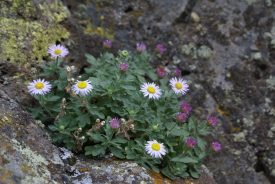Rare Plant Profile: Basalt Daisy

Basalt daisy (Erigeron basalticus) is a cliff dweller, found exclusively along the Yakima River Canyon and Selah Creek. There you will find it tucked into crevices and cracks of the basalt cliffs formed in the late Miocene (5 to 11 million years ago). There are six known populations in Washington State. Over the past few years Rare Care has made a concerted effort to re-monitor all known occurrences, and we only have one left to visit! As a plant that grows on tall canyon walls, most of these plants require binoculars or a high-powered spotting scope to view. Sometimes a monitoring effort even requires a float down the Yakima River or Selah Creek. Other populations are growing in road cuts.
Once you do have the basalt daisy in your sights, look for white ray flowers that dry to pink or pinkish purple. Flowering occurs from late May to mid-June and occasionally into August. The stems are 10-15 cm long, branched, and leafy, especially towards the tip. Leaves are 1.5-4 cm long, wedge-shaped, and irregularly three-lobed at the tip. Hidden in the crack is the basalt daisy’s strong taproot that anchors it to its precarious perch. You will usually find basalt daisy growing alone but its associated species are Columbian goldenbush (Ericameria resinosa), roundleaf alumroot (Heuchera cylindrica), Richard’s beardtongue (Penstemon richardsonii), cutleaf thelypody (Thelypodium laciniatum), Sandberg bluegrass (Poa secunda) and cheatgrass (Bromus tectorum).
Although each population is only visited about every 10 years, we believe them to be holding steady.